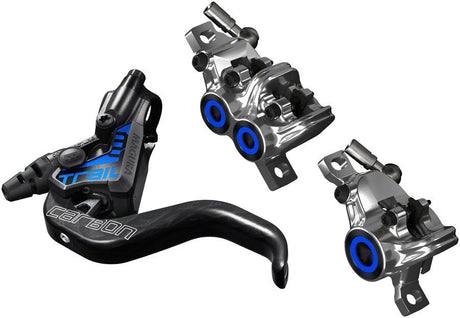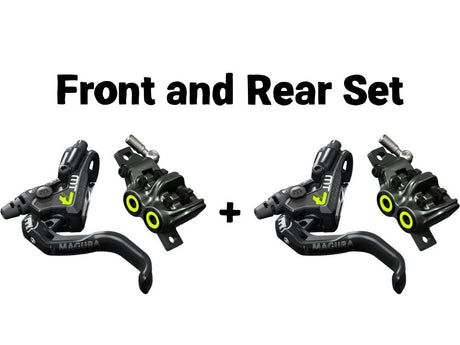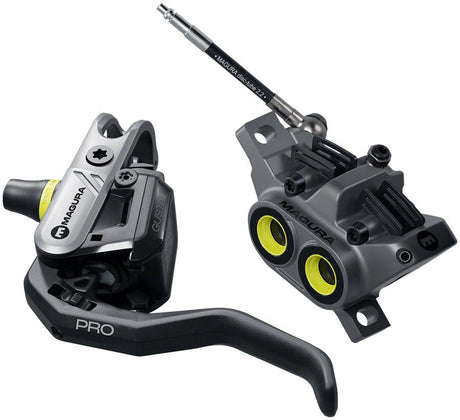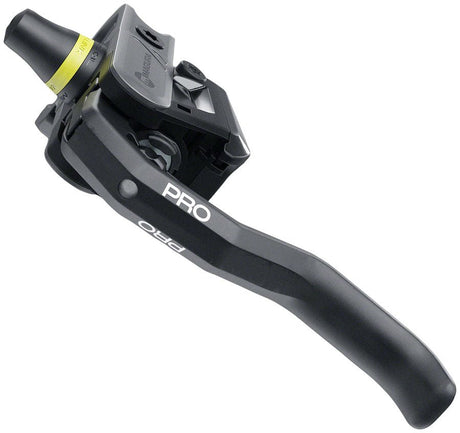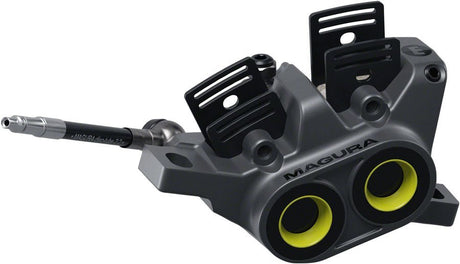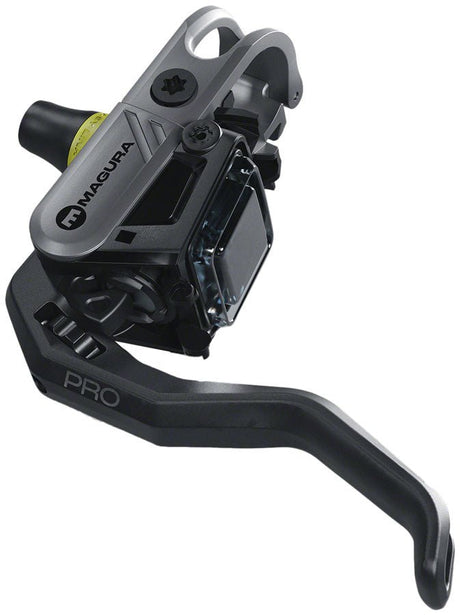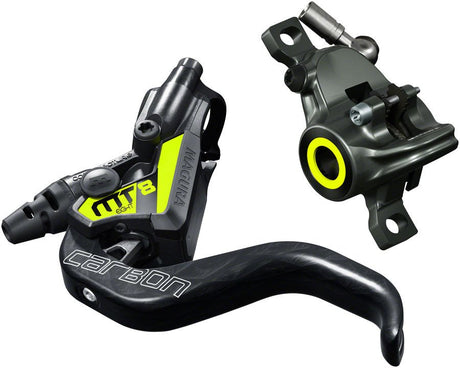The Brake Down:
- TRP DH-R EVO - Modulation kings with an industrial build and a squared off lever shape.
- Magura MT7 - Lightweight construction with most adjustability and consistent performance.
- Hayes Dominion A4 - Frictionless lever throw with robust design and easy to bleed.
Intro
Product Managers across all bike brands do their best to spec their builds with components that will appeal to the widest audience possible, and this can lead to just about every brand having the exact same suspension, drivetrain, brakes, and everything else you can imagine. What if you’re more of an outlier, and want to differentiate your bike from those around it? Well, you’ll be forced to enter the realm of aftermarket components, and today, we’ll be diving into the world of brakes.
There are a few familiar faces leading the charge, and we’ll compare offerings from TRP, Magura, and Hayes to help you decide which one is going to be the best fit for you. These days, every major brake manufacturer has figured out how to build a four piston brake system that has more power than you know what to do with when run with big rotors, quality pads, and a solid bleed, so the nuances are what sets them apart now.
Everything from heat dissipation to lever shape to brake pad compounds come into play, and we’re going to arm you with all the information you need to buy your next set of brakes.
Let's Meet The Brakes
From TRP brakes, we’ll be looking at their most powerful offering, the DH-R EVO, which was actually originally designed for E-Bikes! Some of their athletes started testing them on their DH bikes, and now that’s quickly become their targeted discipline. Their price starts at $269 an end, depending on the color.
From Magura, we’ll be looking at their MT7s with the HC3 lever upgrade. Those fluorescent yellow levers and calipers are unmistakable, and we’ll be seeing if their performance matches the statement they make on the bike. At $299 an end with the HC3 levers, the Magura name is often synonymous with high performance, and these are certainly at the top of some riders' wishlists.
Last but not least, we’ll be looking at the Hayes Dominion A4s, priced at $249. Hayes’ reputation has fluctuated back and forth over the years. They were originally leading the charge in hydraulic disc brake performance back in the 90’s, but then fell a bit behind their competitors in following disc brake systems. Now with the Dominion A4, they’re completely redesigned with a better understanding of what today’s riders demand from their brakes and are right back at the sharp end of things.
Both the MT7s and Dominion A4s were tested with 220mm HS2 rotors from SRAM front and rear, while the TRP DH-R EVOs were tested with TRP’s slightly thicker 2.3mm rotors, also in 220mm front and rear.
Build Quality and Features
TRP DH-R EVO's
Right out of the box, I was very impressed by the build quality of the TRP DH-R EVOs. Something about a beautifully CNC’d part will always catch my eye and these brakes are a work of art. With attention to detail like the little dimples drilled out of the lever for extra traction, it’s hard not to like the industrial look of these brakes. We’ve got them pictured here in the black, but they also come in silver or gold if you’re looking for a little more bling!
Simplicity is often king, and there’s only one adjustment to be found on the lever of the DH-R EVOs. Once you have the lever reach adjustment dialed in, that’s the end of the tinkering line and it’s time to hit the trails. Another plus of these brakes is that they use the same pads as Shimano brakes, meaning you’ll be able to get replacements at any bike shop worth their salt.
Magura MT7
The Magura MT7s are the only calipers machined out of a single piece of forged aluminum instead of two pieces being screwed together, which gives the caliper increased rigidity over a typical two piece design. Up to the lever, it’s made of their Carbotexture composite material that saves weight while not compromising on structural integrity. It’s also symmetrical on the top and bottom, meaning there isn’t a specific right and left lever. The MT7s also come in a more muted gray if the highlighter yellow says a little more than you want it to.
We had the pleasure of riding the MT7s with the optional HC3 lever, which gives an impressive three adjustments built into the lever blade alone. The standout feature to me is the Ratio Adjust which allows you to adjust the ratio of power transmitted to the caliper as you pull the lever. You want more power? You got it! Alongside it, there are also two separate adjustments to help you get the lever exactly where you need it.
Back down at the caliper, each one has 4 brake pads, meaning 8 for the entire bike! Magura claims that this helps keep temperatures down, which is a positive considering Magura only offers resin pads for all brake models they manufacturer. There are sintered and ceramic aftermarket options available from other retailers, but we haven’t gotten a chance to test those out just yet.
Hayes Dominion
With the Hayes Dominion A4, we’ve got another fully metallic affair, with a two piece forged aluminum caliper and lever. They even have aluminum pistons tucked inside of those calipers! With a svelte figure and defined lines along the body of the lever, I was reminded of a fighter jet or an exotic car, and the levers can also be flipped around and run on either side, just like the Maguras.
Right in the armpit of the brake lever, you’ll find the Dead Stroke adjustment, which accomplishes about the same job as the SRAM Contact Adjust dial, controlling the distance your pads travel before pinching the rotor. It’s also got the classic reach adjust dial on the lever as well.
Installation and Bleeding
Before I dive into the "mechanic" side of these brakes, a quick note. While I have done a lot of bike wrenching in my days, that doesn’t mean I’m the most competent mechanic. I have this innate skill of stumbling into every possible pothole along the way to finding my way to the finish line, so I think I am uniquely qualified to speak on the usability for the home mechanic as opposed to one of our highly qualified professional mechanics that spends all day wrenching on customer’s bikes.
DH-R EVO
The TRP DH-R EVOs were incredibly easy to get installed.
When you open up the box, you’ll find that both levers come disconnected but have their EZ-plug system which makes hooking everything up as straightforward as can be. Little plugs are screwed into the ends of the hose and levers to keep the fluid in there, and TRP has a great instructional video that outlines all the steps to link your lines without breaking out the bleed kit. All you have to do is cut your lines and install the olive and barb before connecting everything.
They felt incredibly crisp and responsive without a bleed after installation but I still did a quick lever bleed to make sure no sneaky bubbles had found their way in and was stoked to see no bubbles got out. Later on, I did have some bubbles find their way into the rear caliper, and it wasn’t the most straightforward job getting them out. It took quite a bit of finagling to coax those last few stragglers through the caliper bleed port, and I had to get help from our more experienced mechanics to get a bleed I was happy with.
Another thing to note is TRP’s use of their mineral oil over DOT fluid. I think the mineral oil vs DOT fluid debate is a little blown out of proportion, and either works great in modern brake systems. You don’t want to drink either of them and need to thoroughly clean up after working with either of them so it seems like a non issue to me. TRP’s own mineral oil boasts a very impressive 270 degree C boiling point, about the same as DOT 5.1. And, they also won’t suffer from absorbing water like DOT fluid so it’ll retain that boiling point for as long as it’s in the system.
Magura MT7
Magura MT7s were absolutely the brake that intimidated me the most before installation, as I’d always heard how finicky they are to get a quality bleed, but that just wasn’t the case! They came preconnected so of course I had to shorten both sides by cutting them down, reinstalling the hose, and then bleeding. When I used their bleed kit I didn’t have any trouble getting those pesky bubbles to trickle out, and after riding these brakes the most of the three on the test, they are the only ones that I haven’t felt the need to rebleed at some point.
One thing to note is the screw on the lever bleed port is very fragile, and has an absurdly low torque spec of 0.5 Newton meters. There are places to push the limits with mountain biking, and this is not one of them! Just thread it in until it’s fully inserted and nothing beyond that! Inside that bleed port you’ll find Magura’s Royal Blood brake fluid, which is Magura’s in-house mineral fluid that’s designed to lube the system as you use it. Because it’s a mineral oil, it won’t absorb water from condensation and should perform optimally for as long as it’s in the system.
Hayes Dominion
The Hayes Dominion A4s have a couple of unique features that make installation and bleeding more pain free than it otherwise could be.
During the first installation, the Crosshair Caliper Alignment system allows you to precisely slide the caliper along the mounting bracket until you entirely eliminate all rotor rub. As for successive installs, it was just a matter of tightening the caliper bolts while snugging the caliper against the Crosshair bolts to perfectly center your rotor. If getting the caliper centered after installation is a headache for you like it is for me, then this little feature is something you’ll come to love.
Another much appreciated feature on the Dominions is the dual bleed ports on the caliper. The delicate dance of maneuvering bubbles from behind the opposite pistons is no more with bleed ports on either side. While bleeding both other systems I absolutely wish that they had this feature, or if you prefer not to open up the caliper twice, you can ignore the second port and bleed the brake as if it was normal.
Surprisingly, the Hayes Dominion A4s are the only brakes in this test to use DOT 5.1 fluid, meaning you want to make extra sure to wear gloves and thoroughly clean up after installation. Also found in the box is an extra set of brake pads! Their semi metallic pads come installed in the calipers and a set of sintered pads are included as well. A very considerate addition from Hayes.
Performance
I mentioned it briefly in the beginning of this article but it’s worth reiterating that all three of these brake systems delivered more than enough power in both wet and dry conditions.
Unfortunately (or perhaps fortunately), ABS systems haven’t trickled their way into mountain biking just yet, so all of that power is nothing without the modulation to go along with it. I would be perfectly happy to run any one of these three products for as long as I keep mountain biking, but luckily, we’re not playing by those rules. So let’s dive into what sets these brakes apart from each other and how they perform when your life literally depends on them.
DH-R EVO
TRP has been synonymous with modulation since their inception, and with the DH-R EVOs, that modulation is paired with vast amounts of power. As you hit that bite point in your lever throw and your pads start pinching your rotors, there is a fantastic initial bite as the lever has a distinct 'bottom out'. But as you push further against that initial wall, the power isn’t afraid to come out and play.
There were no issues with a wandering bite point or any inconsistencies at all, and the resin pads that came with the brake system performed surprisingly well on long descents. I wasn’t able to overheat the system to the point of losing noticeable power on my favorite local 2500 foot descent. I’m sure that the thicker 2.3mm rotor was a factor in helping to dissipate heat, but the fact that the resin pads didn’t glaze over stood out to me regardless. After switching over to the metallic pads as our weather shifted to a rainy fall, there was a less distinct initial bite compared to the resins, but there was increased power later in the lever throw.
Something that plagued me throughout my time on the DH-R EVOs was the bulky handlebar mount that felt as if it had a personal vendetta against the rest of my controls. Both my OneUp V2 Dropper Lever and X01 Eagle shifter had to be moved either inwards or outwards to make room for the TRP brake levers. Personally, brake lever placement is without a doubt the most important part of feeling comfortable in your cockpit, so both the dropper lever and shifter had to slide out of the way for the newcomers.
Shape of the lever blade is a subjective point, and none of these have an inherently better or worse shape, but they are all slightly different. The DH-R EVO’s levers measure within one mm of the other brakes on test at the tallest point, but are more filled out with the largest flat contact patch for your finger to lay on. This leads to them feeling a bit thicker than the other levers, but it’s a marginal difference.
Magura MT7
My first experience with incredibly powerful brakes was actually a few years ago when I borrowed a friend’s bike with the Magura MT7s bolted to it. At the time I was accustomed to some poorly set up brakes from another brand, and as I was coming into the first corner on my home trail which I’d ridden probably a thousand times, I grabbed the levers with the same hamfisted force I was used to and was RKO’d into the dirt faster than I thought was possible. Ever since that day, I’ve kept my brakes in far better condition, and have been excited to get a set of my own MT7s.
The action of the MT7 lever feels akin to a Shimano, in that there’s a bit of a ‘hump’ to overcome before getting to the bite point. It’s less noticeable than the Shimanos, but it’s certainly present. I think this little increase in force to get to the bite point is a strategic move by the manufacturer to trick you into pulling your brake levers harder, and thus get your pads to ‘bite’ more, but I digress.
The engagement of the pads feels softer with the MT7s compared to other brakes, and I’m not sure if it comes from flex in the lever or how the master cylinder is designed. Either way, if the TRPs have a 'thunk' as they engage, then the Maguras are closer to a 'whoosh'. There’s still a definite bottom out in the lever action, but there’s a bit of a cushion between you and that wall. Much like the TRPs, there’s an impressive amount of power as you push against that wall, and I can guarantee that they won’t be holding you back. Besides in the way that brakes are supposed to of course.
One unfortunate thing about Magura is that they don’t offer any OEM sintered metallic pads, so you’ll have to look at 3rd party manufacturers if that’s your compound of choice. It’s a strictly resin affair in the Magura factory, offering their comfort, performance, and race compounds. We did manage to get them on a zoom call but they were understandably tight lipped about the compounds themselves. After wearing through a set of each of them, the race compound gave me the most bite and power of the three and has been my pad of choice since. Overheating wasn’t an issue that I ran into with the MT7s, and this could be a product of the quad brake pad design. By keeping some space between the pads and giving them a bit more cooling surface area, more heat gets taken out of the pads by the air rushing over them.
Even with all of the modularity of the HC3 lever, there’s no changing the shape of the actual lever your finger is pulling on. With the most rounded profile of the three levers, and the shortest height by 1 millimeter, this is the thinnest feeling lever of the three.
Hayes Dominion
I know we’ve all done it, the quick squeeze of the brake lever of pretty much every bike you’ve gotten close enough to touch. If that’s how we’re judging these three brakes, then the Hayes Dominion A4 rises to the top.
After being manufactured from the ground up with the sole intention of reducing friction in every element of the system besides the pad and rotor interface, it’s no surprise that the lever throw is sublime. With almost no effort being required to move the lever through its dead stroke, and a very crisp bite point, these brakes pass the squeeze test with flying colors.
I wish I had a better way to word this, but the Dominion A4 is just the most solid feeling brake we tested. With its full metal design, seamless operation, and deep reserves of power, the Dominion A4 inspired confidence in every section of trail I put it through. Initially, I started with the semi metallic pads that come pre-installed in the calipers and was very happy with their bite and consistency on extended downhills but I did install the metallic pads after a bit just to test everything. Like all metallic pads, they perform best once you get them up to their operating temperature, so after getting some heat in them, they bit very consistently with no issues.
As you run up against the bite point in the lever throw in the Dominion A4s, you’re greeted with a reminiscent feel to the DH-R EVOs, which is certainly a positive. You’ll find that same recognizable wall with the initial bite, but as you push against that wall, there’s not much more throw or squish in the lever. That means you’ll be generating as much power as you want without bringing that lever closer to the bar and the rest of your fingers.
Unfortunately, the Hayes Dominion A4 Dead Stroke adjustment didn’t work as well as I would have liked. There was a noticeable difference between the two extremes but doesn’t have the same range of adjustment as the SRAM Contact Point adjustment, which is the only other system with a similar function. Fortunately, I never felt like I wanted it somewhere out of the range of adjustment, so this wasn’t something that would keep me running this brake.
Final Thoughts
So who is each of these brakes for? Well it’s not as easy as being able to declare a clear winner because each of these brakes do different jobs incredibly well, and like I said earlier, none of these brakes held me back in how I wanted to ride at all.
What matters are your priorities outside of pure power when it comes to things like bleed procedures, lever adjustments, or pad compounds.
TRP has built a fantastic brake, with a no-frills approach to their performance. Especially in the black color, this is one of the most nondescript high end brake systems I’ve seen, with minimal branding and no extra frills. For someone who is looking for the most straightforward and industrial brake system, it’s hard to recommend anything but the TRP DH-R EVO’s, especially with their Shimano brake pad compatibility. With seriously dependable performance and beautifully machined CNC parts, the DH-R EVO’s are one of the most popular downhill and enduro brakes for a reason! One thing to keep in mind is that you may need to buy TRP’s shifter and dropper adapters to set your cockpit up comfortably, as I had issues with my controls running into each other on the handlebars.
If you are incredibly picky about your lever feel and placement, then the MT7’s are the clear winner. With four different levers, and 3 way adjustability in their HC3 levers, I believe there’s a configuration for just about anyone. Also after putting the most hours on these brakes than any other mentioned in the review, they are the only ones that I haven’t felt the need to rebleed after setup, offering the exact same pull time and time again. Also, if you aren’t worried about the adjustability of the HC3 lever, you can save yourself $120 a pair with Magura’s more typical and less adjustable lever.
With features like the Caliper Crosshair system and dual bleed ports on the caliper with the intent of easing maintenance woes, working on the Dominion A4's was certainly the easiest of the three. Brake bleeds are a job that I am pretty apprehensive to do on my own, and I typically struggle to get those last couple bubbles out. But with the dual caliper bleed ports, I got a better bleed in less time than the other two brake models, and am more confident in repeating the process in the future. Combining this with the outstanding lever feel, the Dominions are some of the best brakes I’ve gotten the chance to try out. But for those of you who are counting grams, these are the heaviest brakes in the test, weighing about 315g for the front brake, about 15g more than the TRP’s and 50g more than the MT7’s.
For anyone looking to switch things up and spice up their braking life, I feel confident in recommending any of these three brakes. Luckily we’re not in a world with just options from two Big S’s in the braking department, and lots of brands have some great offerings.

